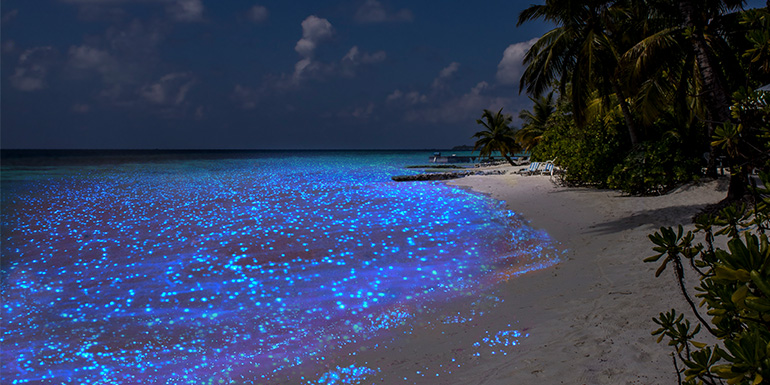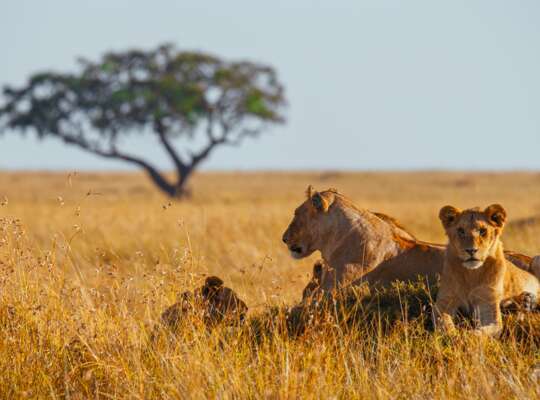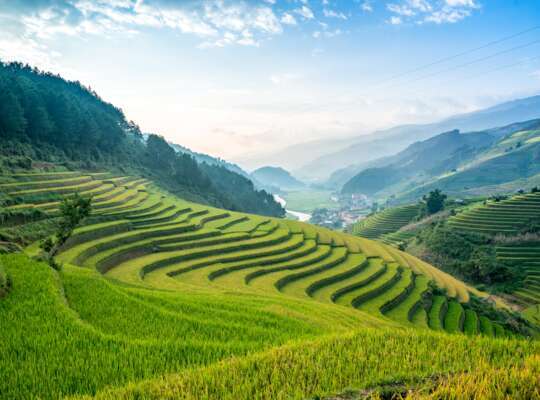From adding texture to an abstract close-up, here’s our guide on how to capture some of the world’s most legendary landmarks in a new light.
Taj Mahal: without the crowds
Grand bulbous domes, polished white marble and intricate archways make up one of the most extraordinary monuments ever created. The Taj Mahal in India is a show-stopping piece of art, bursting with romance and history. A trip to Agra wouldn’t be complete without getting a few classic shots of this architectural marvel, so visit at sunrise or sunset and build up a bank of these first, then let your imagination take over. Explore the grounds and you’ll find some fantastic spots for an artistic close-up or atmospheric silhouette, but if you want to capture its beauty without the crowds and avoid the classic Diana’s bench shot, take a step back and photograph it from a distance.
How to get the angle: Get this shot of the back of the Taj Mahal from the Yamuna River, or take a good zoom lens with you and photograph it from Agra Fort, which is open from sunrise to sunset.
![]()
Mount Fuji: use layers
Mount Fuji in Japan has been snapped so many times that avoiding a clichéd photograph can be a challenge, but using contrasting textures and layers can really transform an image. This shot of the Hakone Ropeway cutting across the mountain was taken on a clear day at Owakudani, a volcanic valley home to hiking trails and hot springs. You can see five clear layers in this photograph – frayed grass, a forest of green trees, the grooves of the rolling hills, the soaring mountain and a strip of blue sky. Add in a little texture – some boxy gondolas and Mount Fuji’s snowy white tip – and you’ve got yourself a more refreshing shot.
How to get the angle: Join our Images of Japan escorted small group photography tour with award-winning travel photographer Neil Buchan-Grant, which visits the Hakone Ropeway.
![]()
Saint Basil’s Cathedral: create drama
The quirky-looking Saint Basil’s Cathedral in Russia was built back in the 1500s. Its patterned onion-shaped roofs tower over Red Square – Russia’s ancient centre, which once hosted high-profile executions and World War II military parades. If you want to capture the cathedral’s dramatic structure, history and mysterious feel, make the most of a sunset in Red Square. Wait for a glimpse of light to peek through the clouds, creating a glow on the cathedral’s burnt-orange walls, and use your lens to tell a story full of enigma and intrigue.
How to get the angle: Our Images of Russia escorted small group tour with travel photographer Neil Buchan-Grant includes an exclusive photoshoot in Red Square at dusk (subject to confirmation). Taking photographs here is usually not permitted at this time, due to government restrictions.
![]()
Machu Picchu: take us there
You feel like you’re spying on Huayna Picchu mountain in this photograph. The window almost looks like a picture frame, bordering one of Peru’s superstar attractions. This shot was taken from the Machu Picchu citadel and instantly draws you in. It’s like you’re standing there yourself, peering out towards the cobbled ruins leading you to the mountain.
How to get the angle: Take our Classic Inca Trail tour and follow some of the world’s most famous trekking routes. Hike through cloud forest to get to the citadel, where you can climb the terraces and try out a few diverse angles and frames.
![]()
Pyramids of Giza: add height
When it comes to the Seven Wonders of the Ancient World, Egypt’s Pyramids of Giza is the only one to still exist. Khufu, Khafre and Menkaura, the three main pyramids, were built as royal tombs for the pharaohs around 5000 years ago. Now, they’re one of the world’s most legendary landmarks, photographed by millions every year. This shot of the Great Pyramid of Khufu is very powerful. Angling the lens towards the sky from a low standpoint makes the pyramid appear infinite – as if it stretches into the heavens, its colossal height dwarfing you.
How to get the angle: Get up close and personal to this fascinating relic on our half day Pyramids and Sphinx tour. You could also stay at Cairo’s historic hotel, Mena House, which has incredible views of the pyramids and is just a 10-minute walk away.
![]()
Statue of Liberty: play with perspectives
New York City is a photographer’s wonderland – from Brooklyn Bridge, to Central Park and Lady Liberty herself. It’s the city that never sleeps (and your camera won’t either). Around four million people visit the Statue of Liberty every year, so you can imagine just how many times she’s been papped. The statue is a beacon of hope and freedom, and that sense of liberation is almost tangible in this picture. You feel in awe of her almighty presence, with the torch tight in her grip and the golden flame stretching towards the sky.
How to get the angle: Hop in a cab or take the subway to Jersey City’s Liberty State Park, where you can capture the statue with her back to you.
![]()
Sydney Opera House: get a close-up
This great architectural icon in Australia was the vision of Danish architect Jørn Utzon, who got the job after winning an international competition. The roof’s complex curved ‘shells’, which jut out over the Sydney Harbour, were thought to symbolise white sails. But Utzon cleared up that myth a few years ago – they were actually inspired by orange peel segments! UNESCO described the Sydney Opera House as ‘one of the indisputable masterpieces of human creativity’ when it bagged a spot on the World Heritage List in 2007. Today, it’s one of Australia’s most famous attractions, but you rarely get to see the intricate details of its unusual design in most tourist snaps.
How to get the angle: You’ll need to use a zoom lens to get a close-up shot like this. And make the most of the contrast between the geometric roof tiles and bright blue sky to create an interesting composition.
![]()
Table Mountain: shoot from above
A trip to the top of Table Mountain is a Cape Town must-do, so catch a cable car ride or pull on your walking boots for a hike. When you reach its flat-topped peak, you’ll be met with astounding city and sea views, and thousands of different plant species – some of which you won’t find anywhere else on Earth. Table Mountain is South Africa’s most photographed attraction, so if you want to get inventive, hop in a helicopter and head for the clouds for a private window seat to this special natural wonder.
How to get the angle: This picture captures the sheer scale of Table Mountain towering over the city below. For a spectacular bird’s-eye view like this, take our Cape Town helicopter tour.
![]()
Photography tip
One of our most popular destinations is the Maldives and, during a stay here, you may be able to spot the rare spectacle of bioluminescent plankton, glowing in the water at night. Capturing it on camera is a big challenge, so we asked award-winning marine wildlife photographer Doug Perrine for his top tip on how to get the best shot.

“It’s very helpful if you can control your camera settings manually, especially the exposure time, so you can set the shutter for a long exposure (10 seconds to a minute or more). During a long exposure, the movement of the water will blur the wave wash, which is fine, but it’s critical to prevent the other parts of the image from blurring due to camera motion. That can be accomplished by using a tripod, a camera clamp or a selfie stick stuck in the sand. It’s also very useful to have a shutter release cable to prevent jarring the camera at the beginning of the exposure. Use a delayed shutter release, and, if you are using an SLR camera, lock up the mirror before the exposure.”
Inspired?
If you want to hone your photography skills or build up your Instagram page with some inventive travel shots, tell us about the places you’d love to capture on camera and we’ll tailor your holiday around them. Talk to one of our Personal Travel Experts or book an appointment in your local Kuoni store today.







_w=24_h=25.webp?v=b71667f1b0243497a8c080edd5d032e11f899818)
_w=24_h=25.webp?v=b71667f1b0243497a8c080edd5d032e11f899818)
_w=24_h=25.webp?v=b71667f1b0243497a8c080edd5d032e11f899818)